VOLKSWAGEN TRANSPORTER 1990 T4 / 4.G Owners Manual
Manufacturer: VOLKSWAGEN, Model Year: 1990, Model line: TRANSPORTER, Model: VOLKSWAGEN TRANSPORTER 1990 T4 / 4.GPages: 165, PDF Size: 24.87 MB
Page 121 of 165
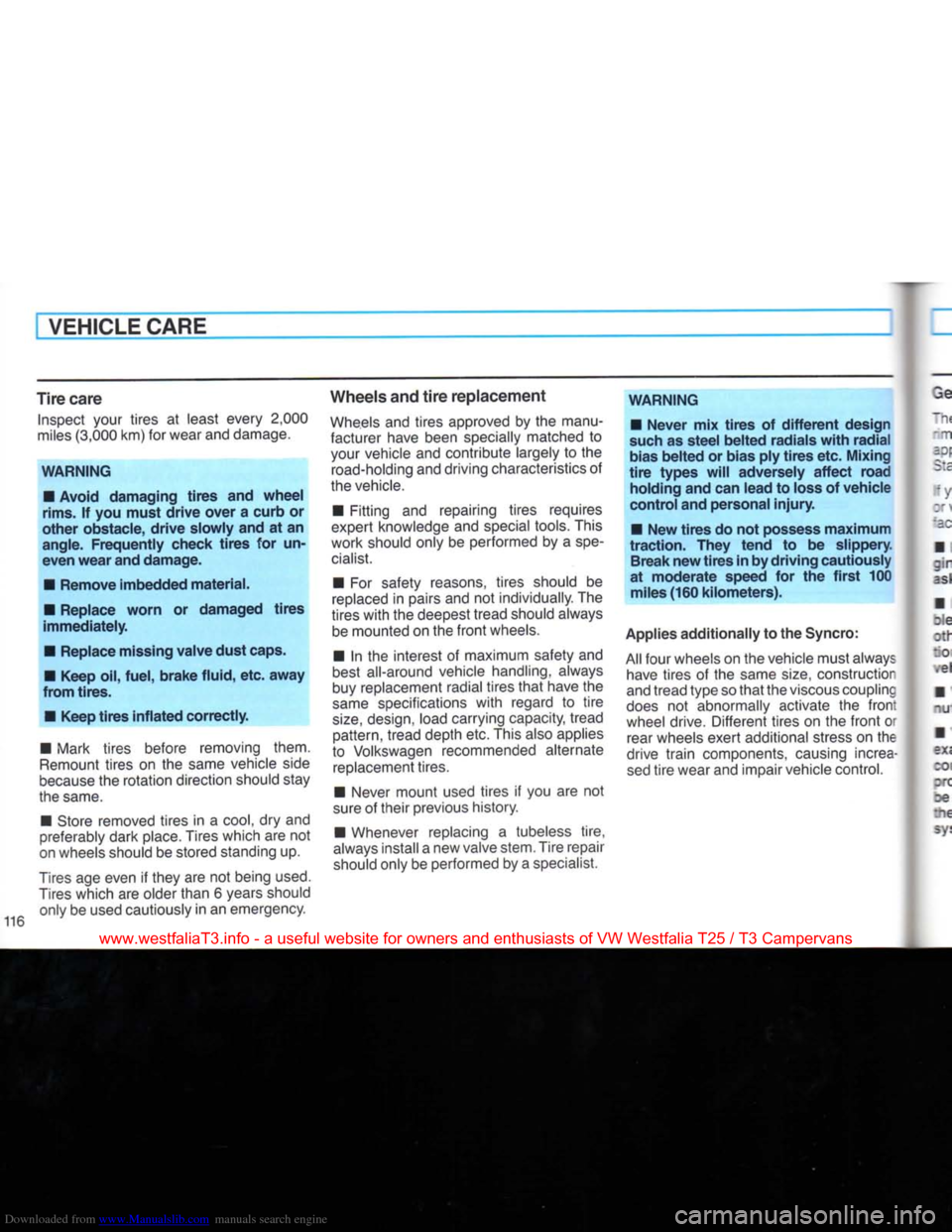
Downloaded from www.Manualslib.com manuals search engine
VEHICLE CARE
Tire
care
Inspect your tires at least every 2,000
miles (3,000 km) for wear and damage.
WARNING
• Avoid
damaging
tires
and
wheel
rims.
If you
must
drive
over
a
curb
or
other
obstacle,
drive
slowly
and at an
angle.
Frequently
check
tires
for un
even
wear
and
damage.
•
Remove
imbedded
material.
•
Replace
worn
or
damaged
tires
immediately.
•
Replace
missing
valve
dust
caps.
• Keep oil,
fuel,
brake
fluid,
etc.
away
from
tires.
• Keep
tires
inflated
correctly.
• Mark tires before removing them.
Remount tires on the same vehicle side
because
the rotation direction should stay
the same.
• Store removed tires in a
cool,
dry and
preferably dark place. Tires which are not
on wheels should be stored standing up.
Tires
age even if they are not being
used.
Tires
which are older than 6 years should only be used cautiously in an emergency.
Wheels
and
tire
replacement
Wheels
and tires approved by the manu
facturer have been specially matched to
your vehicle and contribute largely to the road-holding and driving characteristics of
the vehicle.
• Fitting and repairing tires requires
expert knowledge and special tools. This
work should only be performed by a
spe
cialist.
• For safety reasons, tires should be
replaced
in pairs and not individually. The
tires
with
the deepest tread should always be mounted on the
front
wheels.
• In the interest of maximum safety and
best all-around vehicle handling, always
buy replacement radial tires
that
have the
same
specifications
with
regard to
tire
size,
design, load carrying capacity, tread pattern, tread depth etc. This also applies
to Volkswagen recommended alternate replacement tires.
• Never mount used tires if you are not
sure of their previous history.
• Whenever replacing a tubeless tire,
always install a new valve stem. Tire repair
should only be performed by a specialist.
WARNING
•
Never
mix
tires
of
different
design
such as
steel
belted
radials
with
radial
bias
belted
or
bias
ply
tires
etc.
Mixing
tire
types
will
adversely
affect
road
holding
and can
lead
to loss of
vehicle
control
and
personal
injury.
• New
tires
do not possess
maximum
traction.
They
tend
to be
slippery.
Break
new
tires
in by
driving
cautiously
at
moderate
speed for the
first
100
miles
(160
kilometers).
Applies
additionally
to the Syncro:
All
four wheels on the vehicle must always have tires of the same
size,
construction
and tread type so
that
the viscous coupling
does
not abnormally activate the
front
wheel drive. Different tires on the
front
or rear wheels exert additional stress on the
drive
train
components, causing increa
sed
tire
wear and impair vehicle control.
www.westfaliaT3.info - a useful website for owners and enthusiasts of VW Westfalia T25 / T3 Campervans
Page 122 of 165
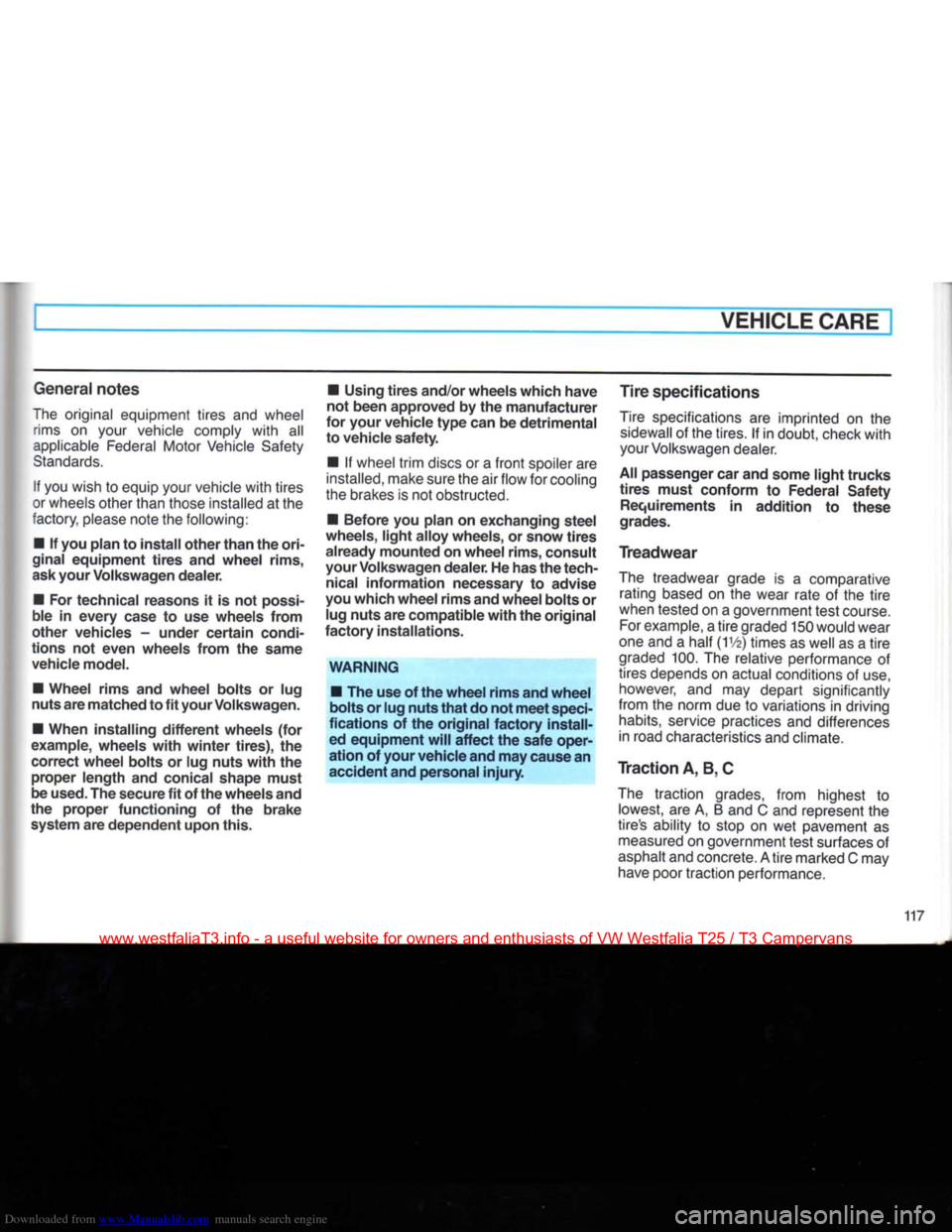
Downloaded from www.Manualslib.com manuals search engine
VEHICLE
CARE
General notes
The original equipment tires
and
wheel
rims
on
your
vehicle comply with
all
applicable
Federal Motor Vehicle Safety
Standards.
If you
wish
to
equip
your
vehicle with tires
or wheels other than those installed
at the
factory, please note
the
following:
•
If
you plan
to
install other than the
ori
ginal
equipment tires
and
wheel rims,
ask
your
Volkswagen dealer.
•
For
technical reasons
it is not
possi
ble
in
every
case
to use
wheels from
other vehicles
-
under certain condi
tions
not
even wheels from
the
same
vehicle
model.
•
Wheel rims
and
wheel bolts
or lug
nuts are matched to fit
your
Volkswagen.
•
When installing different wheels
(for
example,
wheels with winter tires),
the
correct wheel bolts
or
lug nuts with
the
proper length
and
conical shape must
be used. The secure fit of the wheels and
the proper functioning
of the
brake system are dependent upon this.
•
Using tires and/or wheels which have
not been approved
by
the manufacturer
for
your
vehicle
type
can be detrimental
to vehicle safety.
•
If
wheel trim discs
or a
front
spoiler
are
installed,
make
sure the airflow for cooling
the brakes
is not
obstructed.
•
Before
you
plan
on
exchanging steel
wheels, light alloy wheels,
or
snow tires
already mounted on wheel rims, consult
your
Volkswagen dealer. He has the tech
nical
information necessary
to
advise
you which wheel rims and wheel bolts
or
lug
nuts are compatible with the original
factory installations.
WARNING
•
The
use of the wheel rims and wheel
bolts
or
lug nuts that do not meet
speci
fications
of the
original factory
install
ed equipment will affect the safe oper
ation
of
your
vehicle and may cause an
accident and personal
injury.
Tire specifications
Tire
specifications
are
imprinted
on the
sidewall
of
the tires.
If in
doubt, check with
your
Volkswagen dealer.
All
passenger car and some light trucks tires must conform
to
Federal Safety
Requirements
in
addition
to
these
grades.
Treadwear
The treadwear grade
is a
comparative
rating
based
on the
wear rate
of the
tire
when tested
on a
government test course. For example,
a
tire graded
150
would wear
one
and a
half
(IV2)
times
as
well
as a
tire
graded 100.
The
relative performance
of
tires depends
on
actual conditions
of use,
however,
and may
depart significantly
from
the
norm
due to
variations
in
driving
habits,
service practices
and
differences
in road characteristics and
climate.
Traction A, B, C
The traction grades, from highest
to
lowest,
are A, B and C and
represent
the
tire's ability
to
stop
on wet
pavement
as
measured
on
government test surfaces
of
asphalt
and concrete. Atire marked
C
may
have poor traction performance.
www.westfaliaT3.info - a useful website for owners and enthusiasts of VW Westfalia T25 / T3 Campervans
Page 123 of 165
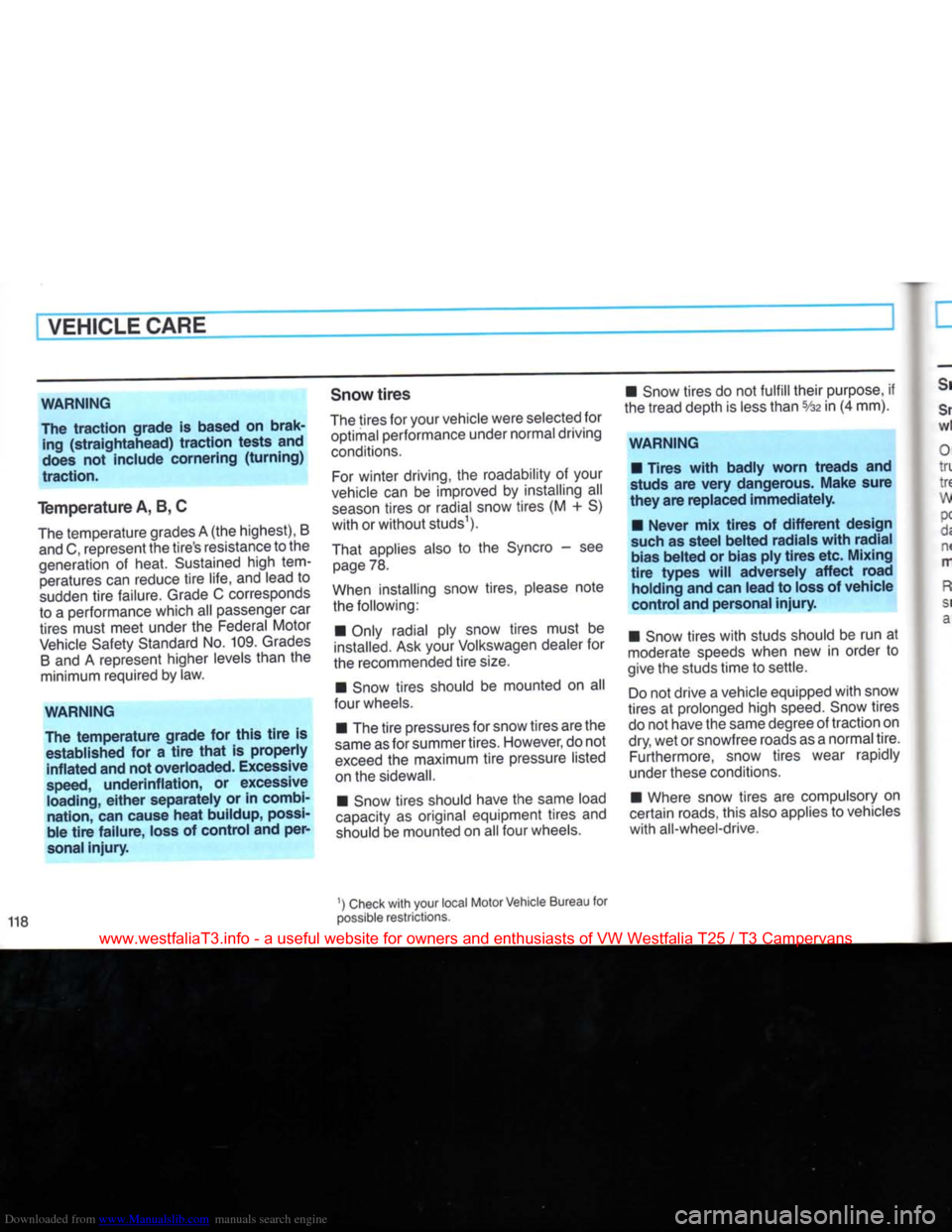
Downloaded from www.Manualslib.com manuals search engine
VEHICLE CARE
WARNING
The
traction
grade
is based on
brak
ing
(straightahead)
traction
tests
and
does not
include
cornering
(turning)
traction.
Temperature
A, B, C
The temperature grades A (the highest), B and C, represent the tire's resistance to the
generation of heat. Sustained high temperatures can reduce
tire
life, and lead to
sudden
tire
failure. Grade C corresponds
to a performance which all passenger car
tires must meet under the Federal Motor
Vehicle
Safety Standard No. 109.
Grades
B
and A represent higher levels than the minimum required by law.
WARNING
The
temperature
grade
for
this
tire
is
established
for a
tire
that
is
properly
inflated
and not
overloaded.
Excessive
speed,
underinflation,
or excessive loading,
either
separately
or in combi
nation,
can cause
heat
buildup,
possi
ble
tire
failure,
loss of
control
and
per
sonal
injury.
Snow
tires
The tires for your vehicle were selected for optimal performance under normal driving
conditions.
For
winter driving, the roadability of your
vehicle can be improved by installing all
season
tires or radial snow tires (M + S)
with
or
without
studs1).
That applies also to the Syncro - see page 78.
When installing snow tires, please note the following:
• Only radial ply snow tires must be
installed.
Ask your Volkswagen dealer for
the recommended
tire
size.
• Snow tires should be mounted on all
four wheels.
• The
tire
pressures for snow tires are the
same
as for summer tires. However, do not
exceed
the maximum
tire
pressure listed
on the sidewalk
• Snow tires should have the same load
capacity as original equipment tires and
should be mounted on all four wheels. • Snow tires do not
fulfill
their purpose, if
the tread depth is
less
than
%2
in (4 mm).
WARNING
•
Tires
with
badly
worn
treads
and
studs are
very
dangerous.
Make
sure
they
are
replaced
immediately.
•
Never
mix
tires
of
different
design
such as
steel
belted
radials
with
radial
bias
belted
or
bias
ply
tires
etc.
Mixing
tire
types
will
adversely
affect
road
holding
and can
lead
to loss of
vehicle
control
and
personal
injury.
• Snow tires
with
studs should be run at
moderate speeds when new in order to
give the studs time to settle.
Do
not drive a vehicle equipped
with
snow
tires at prolonged high
speed.
Snow tires
do not have the same degree of traction on
dry, wet or snowfree roads as a normal tire. Furthermore, snow tires wear rapidly
under these conditions.
• Where snow tires are compulsory on
certain roads, this also applies to vehicles
with
all-wheel-drive.
118 1)
Check
with
your local Motor Vehicle Bureau for
possible
restrictions.
www.westfaliaT3.info - a useful website for owners and enthusiasts of VW Westfalia T25 / T3 Campervans
Page 124 of 165
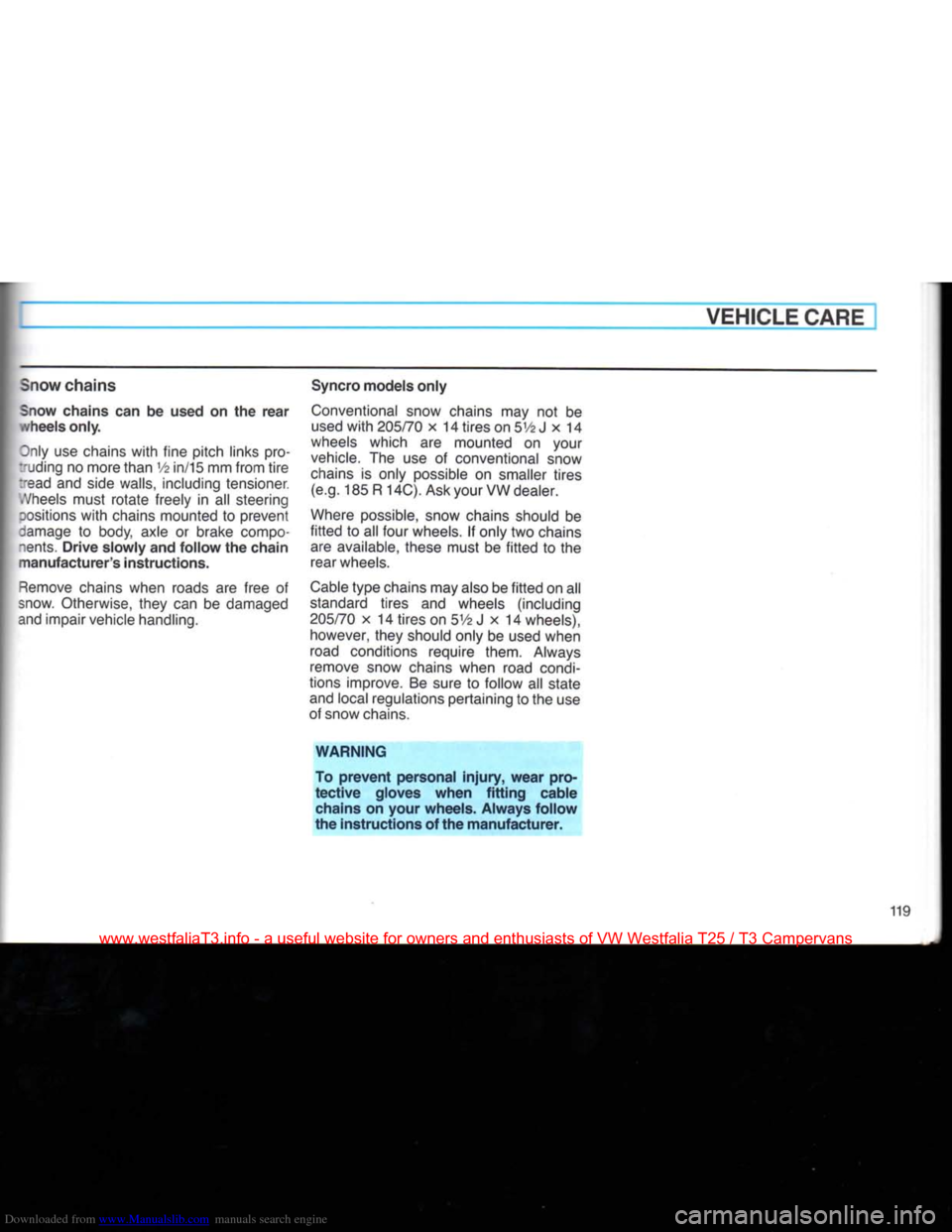
Downloaded from www.Manualslib.com manuals search engine
VEHICLE CARE
Snow
chains
Snow
chains
can be used on the rear ./heels only.
Dnly use chains
with
fine pitch links pro
dding no more than V2 in/15 mm
from
tire
"ead
and side walls, including tensioner.
.'/heels
must
rotate
freely
in all
steering
positions
with
chains mounted
to
prevent
damage
to
body, axle
or
brake compo
nents.
Drive slowly and follow the chain
manufacturer's instructions.
Remove
chains when roads are free
of
snow. Otherwise, they can
be
damaged
and impair vehicle handling.
Syncro models only
Conventional snow chains may
not be
used
with
205/70
x
14 tires on
5V2
J
x 14
wheels which
are
mounted
on
your
vehicle.
The
use
of
conventional snow
chains
is
only possible
on
smaller tires (e.g. 185
R
14C). Ask your VW dealer.
Where possible, snow chains should
be
fitted
to
all four wheels.
If
only two chains are available, these must be
fitted
to
the rear wheels.
Cable
type chains may also be
fitted
on all
standard tires
and
wheels (including
205/70
x
14 tires on 5Vz
J x
14 wheels), however, they should only be used when
road conditions require them. Always
remove snow chains when road condi
tions improve. Be sure
to
follow all state and local regulations pertaining to the use
of snow chains.
WARNING
To
prevent personal
injury,
wear
pro
tective gloves when fitting cable
chains
on your wheels. Always follow
the instructions
of
the manufacturer.
www.westfaliaT3.info - a useful website for owners and enthusiasts of VW Westfalia T25 / T3 Campervans
Page 125 of 165
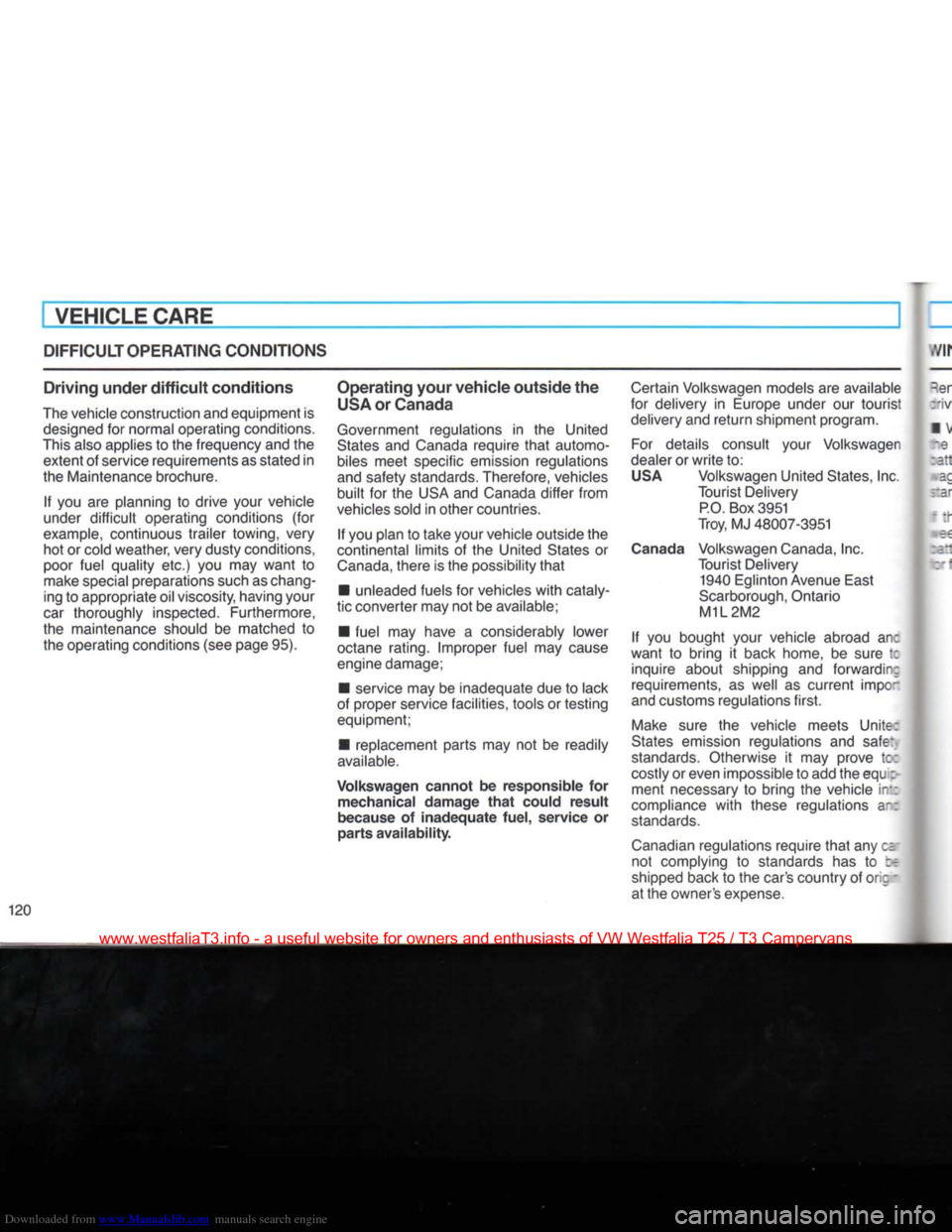
Downloaded from www.Manualslib.com manuals search engine
[VEHICLE
CARE
DIFFICULT
OPERATING
CONDITIONS
Driving
under
difficult
conditions
The
vehicle construction and equipment is
designed
for normal operating conditions.
This
also applies to the frequency and the extent of service requirements as stated in
the Maintenance brochure.
If you are planning to drive your vehicle
under
difficult
operating conditions (for
example,
continuous trailer towing, very hot or cold weather, very dusty conditions,
poor fuel quality etc.) you may
want
to
make
special preparations such as chang
ing to appropriate oil viscosity, having your
car
thoroughly inspected. Furthermore,
the maintenance should be matched to
the operating conditions (see page 95).
Operating
your
vehicle
outside
the
USA
or
Canada
Government
regulations in the United
States
and
Canada
require
that
automo
biles
meet specific emission regulations
and
safety standards. Therefore, vehicles
built
for the USA and
Canada
differ
from
vehicles
sold in other countries.
If you plan to take your vehicle outside the
continental limits of the United States or
Canada,
there is the possibility
that
• unleaded fuels for vehicles
with
cataly
tic converter may not be available;
• fuel may have a considerably lower
octane rating. Improper fuel may cause
engine damage;
• service may be inadequate due to lack
of proper service facilities, tools or testing
equipment;
• replacement parts may not be readily
available.
Volkswagen
cannot be responsible for
mechanical
damage
that
could result
because
of inadequate fuel, service or
parts availability.
Certain
Volkswagen models are available
for delivery in Europe under our
tourist
delivery and
return
shipment program.
For
details consult your Volkswagen
dealer
or
write
to:
USA
Volkswagen United States, Inc. Tourist Delivery
P.O.
Box 3951
Troy, MJ 48007-3951
Canada
Volkswagen
Canada,
Inc. Tourist Delivery 1940 Eglinton Avenue
East
Scarborough,
Ontario
M1L2M2
If you bought your vehicle abroad an:
want
to bring it back home, be sure M inquire about shipping and forwardin:
requirements, as well as current impc
and
customs regulations
first.
Make
sure the vehicle meets Unite:
States
emission regulations and safe:
standards.
Otherwise it may prove tc:
costly
or even impossible to add the eqi : ment necessary to bring the vehicle in::
compliance
with
these regulations a-:
standards.
Canadian
regulations require
that
any c= not complying to standards has to
shipped
back to the car's country of oric -
at the owner's expense.
www.westfaliaT3.info - a useful website for owners and enthusiasts of VW Westfalia T25 / T3 Campervans
Page 126 of 165
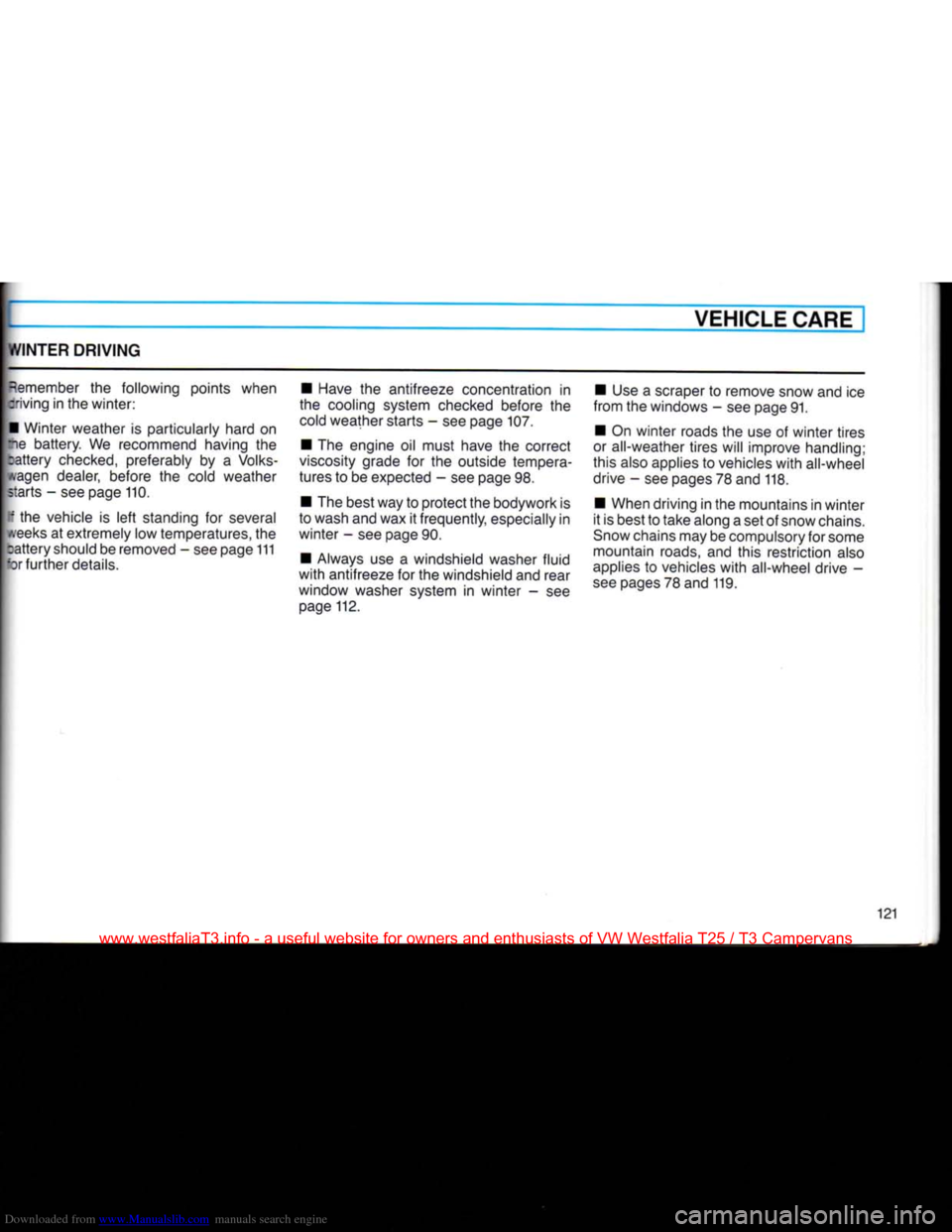
Downloaded from www.Manualslib.com manuals search engine
t'/INTER
DRIVING
VEHICLE CARE
Remember
the following points when
criving in the
winter:
• Winter weather is particularly hard on
ne battery. We recommend having the cattery
checked,
preferably by a
Volks
wagen dealer, before the cold weather starts - see page 110.
If the vehicle is
left
standing for several
iveeks
at extremely low temperatures, the
rattery
should be removed - see page 111
=or
further
details. • Have the antifreeze concentration in
the cooling system checked before the cold weather starts - see page 107.
• The engine oil must have the correct
viscosity grade for the outside tempera
tures to be expected - see page 98.
• The best way to protect the bodywork is
to wash and wax it frequently, especially in
winter - see page 90.
• Always use a windshield washer
fluid
with
antifreeze for the windshield and rear
window washer system in winter - see page 112. • Use a scraper to remove snow and ice
from
the windows - see page 91.
• On winter roads the use of winter tires
or all-weather tires
will
improve handling;
this also applies to vehicles
with
all-wheel
drive - see pages 78 and 118.
• When driving in the mountains in winter
it is best to take along a set of snow chains.
Snow
chains may be compulsory for some
mountain roads, and this restriction also
applies
to vehicles
with
all-wheel drive -
see
pages 78 and 119.
121
www.westfaliaT3.info - a useful website for owners and enthusiasts of VW Westfalia T25 / T3 Campervans
Page 127 of 165
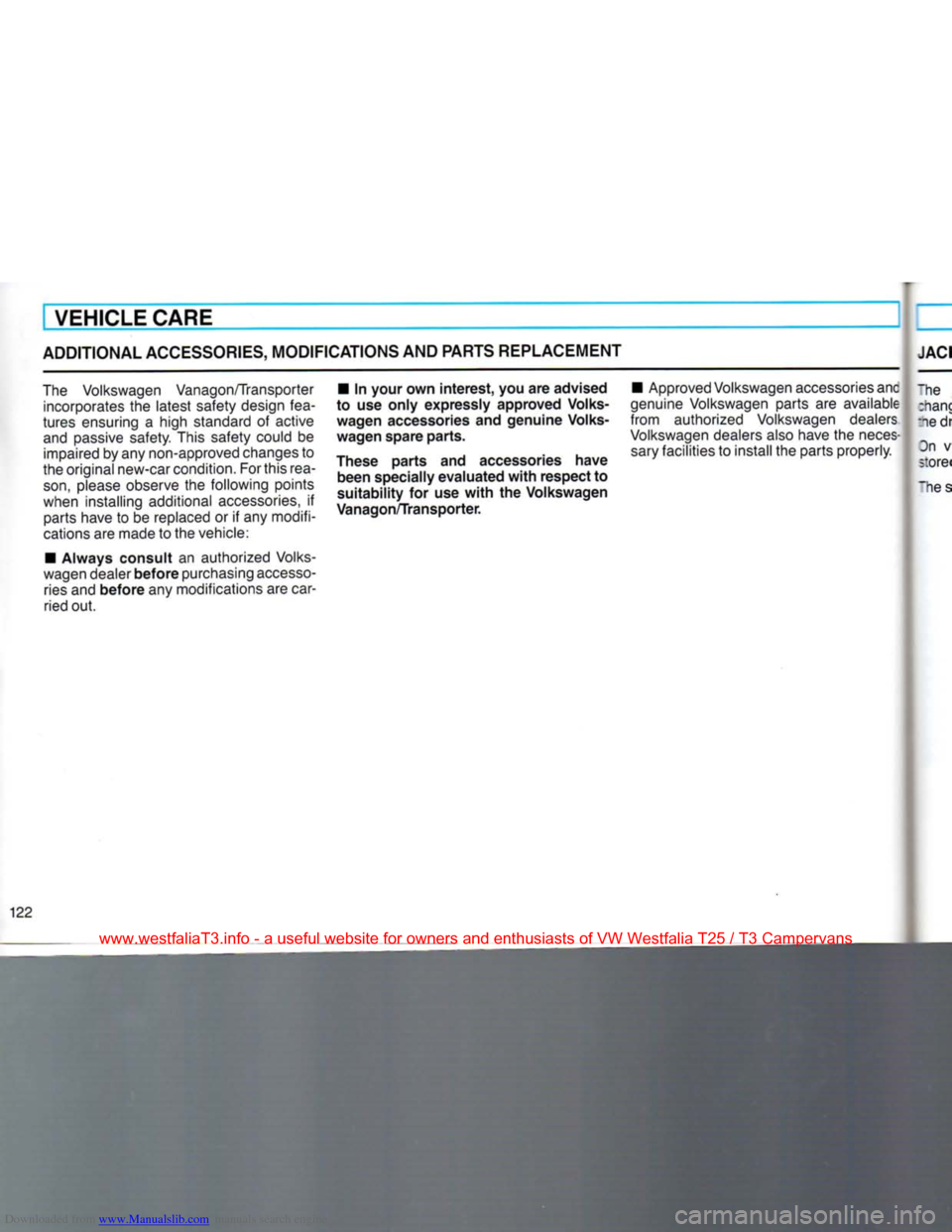
Downloaded from www.Manualslib.com manuals search engine
VEHICLE CARE
ADDITIONAL
ACCESSORIES,
MODIFICATIONS
AND PARTS REPLACEMENT JACI
The Volkswagen Vanagon/Transporter incorporates
the
latest safety design fea
tures ensuring
a
high standard
of
active and passive safety. This safety could
be
impaired
by
any non-approved changes
to
the original new-car condition. Forthis
rea
son,
please observe
the
following points
when installing additional accessories,
if
parts have
to be
replaced
or if any
modifi
cations
are
made
to the
vehicle:
•
Always
consult
an
authorized Volks
wagen dealer
before
purchasing
accesso
ries and
before
any
modifications
are
carried
out.
•
In
your
own
interest,
you are
advised
to
use
only
expressly
approved
Volks
wagen
accessories
and
genuine
Volks
wagen
spare
parts.
These
parts
and
accessories
have
been
specially
evaluated
with
respect
to
suitability
for use with the
Volkswagen
Vanagon/Transporter.
• Approved Volkswagen accessories anc
genuine Volkswagen parts
are
available
from authorized Volkswagen dealers
Volkswagen
dealers also have
the
neces
sary
facilities
to
install
the
parts properly. "he
:hanc
:nedi
Dn
v
s:ore<
122
www.westfaliaT3.info - a useful website for owners and enthusiasts of VW Westfalia T25 / T3 Campervans
Page 128 of 165
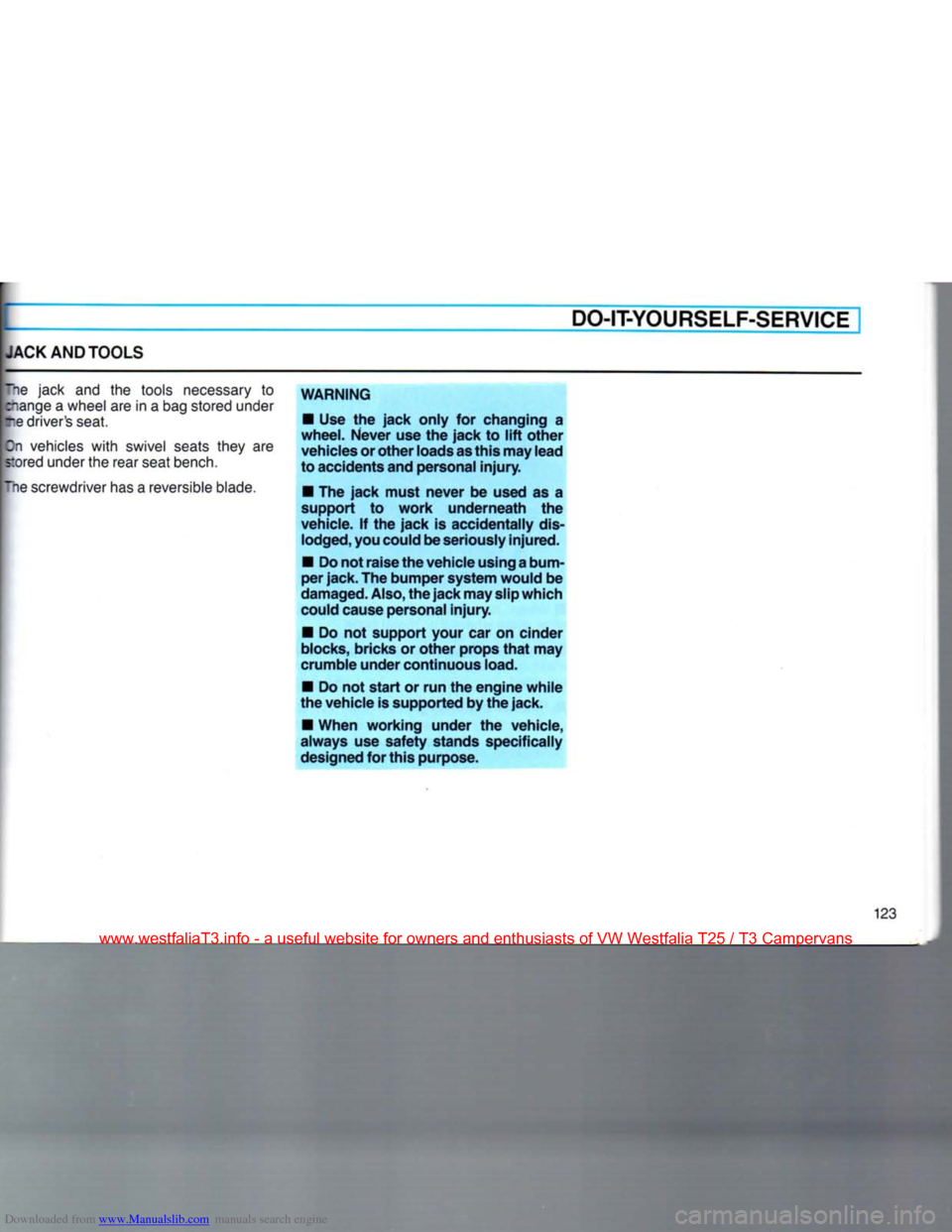
Downloaded from www.Manualslib.com manuals search engine JACK AND
TOOLS
DO-IT-YOURSELF-SERVICE
The jack and the tools necessary to
Bange
a wheel are in a bag stored under
re driver's seat.
Zn vehicles
with
swivel seats they are
stored under the rear seat bench.
~ne
screwdriver has a reversible blade.
WARNING
• Use
the
jack only
for
changing
a
wheel.
Never
use the jack
to
lift other vehicles or other loads
as
this may lead
to accidents and personal
injury.
• The jack must
never
be
used
as a
support
to
work underneath
the
vehicle.
If
the jack
is
accidentally dis lodged, you could be seriously injured.
• Do not
raise
the vehicle using
a
bum
per
jack.
The bumper system would be
damaged.
Also, the jack may
slip
which
could cause personal
injury.
•
Do not
support
your
car on cinder
blocks,
bricks or other props that may
crumble under continuous
load.
• Do not start
or
run the engine while
the vehicle is supported by the jack.
• When working under
the
vehicle,
always
use
safety stands specifically
designed for this purpose.
123
www.westfaliaT3.info - a useful website for owners and enthusiasts of VW Westfalia T25 / T3 Campervans
Page 129 of 165
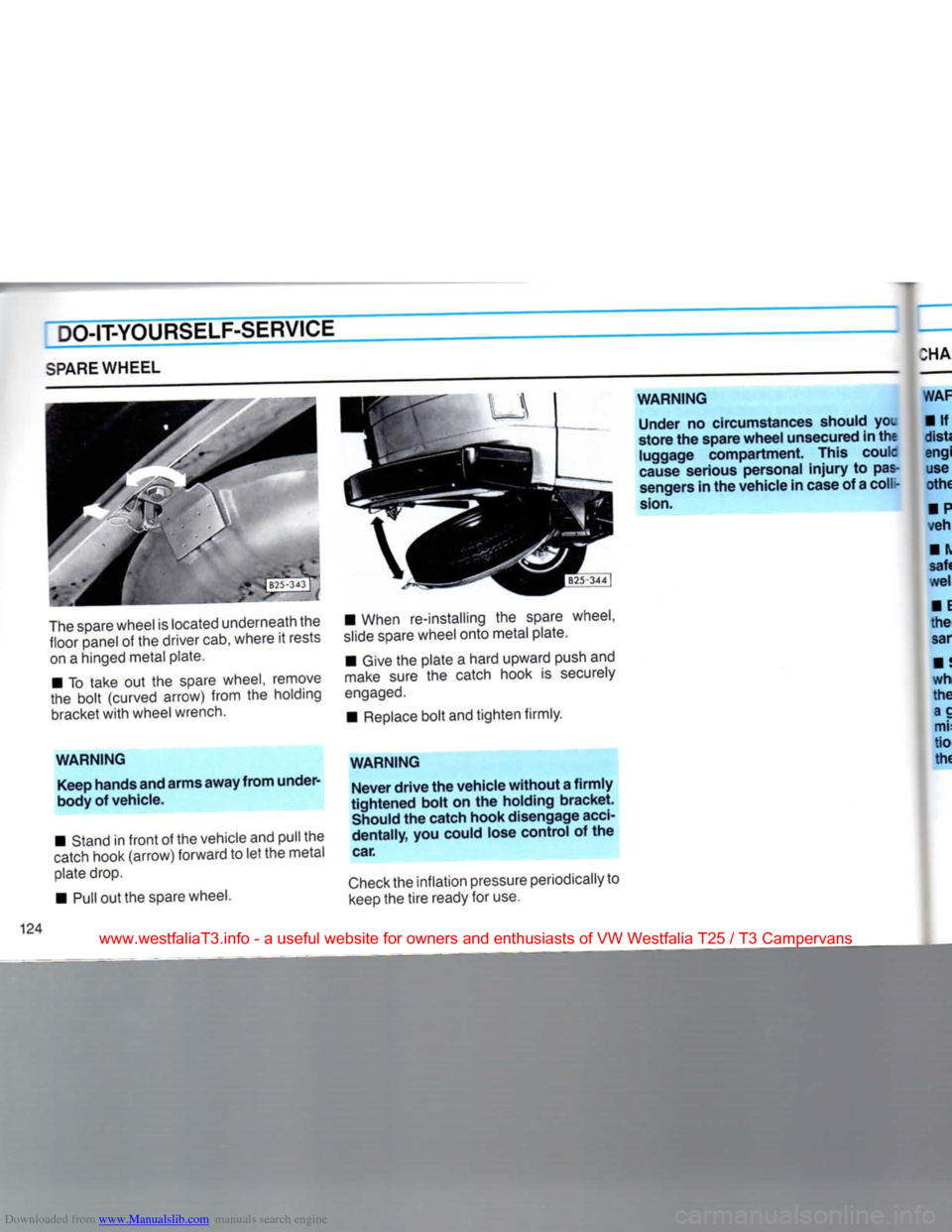
Downloaded from www.Manualslib.com manuals search engine
DO-IT-YOURSELF-SERVICE
SPARE
WHEEL
The
spare wheel is located underneath the floor panel of the driver cab, where it rests on a hinged metal plate.
• To take out the spare wheel, remove
the bolt (curved arrow) from the holding bracket
with
wheel wrench,
WARNING
Keep hands and
arms
away
from
under-
body of vehicle.
• Stand in
front
of the vehicle and pull the
catch
hook (arrow) forward to let the metal
plate drop.
•
Pull
out the spare wheel. • When re-installing the spare wheel,
slide
spare wheel onto metal plate.
•
Give
the plate a hard upward push and
make
sure the catch hook is securely
engaged.
•
Replace
bolt and tighten firmly.
WARNING
Never
drive
the
vehicle
without
a
firmly
tightened
bolt
on the holding
bracket.
Should the catch
hook
disengage acci
dentally,
you could lose
control
of the
car.
Check
the inflation pressure periodically to
keep
the
tire
ready for use.
WARNING
Under
no circumstances should you
store
the spare
wheel
unsecured in the
luggage
compartment.
This coulc
cause serious personal
injury
to pas
sengers in the
vehicle
in case of a coll -
sion.
www.westfaliaT3.info - a useful website for owners and enthusiasts of VW Westfalia T25 / T3 Campervans
Page 130 of 165
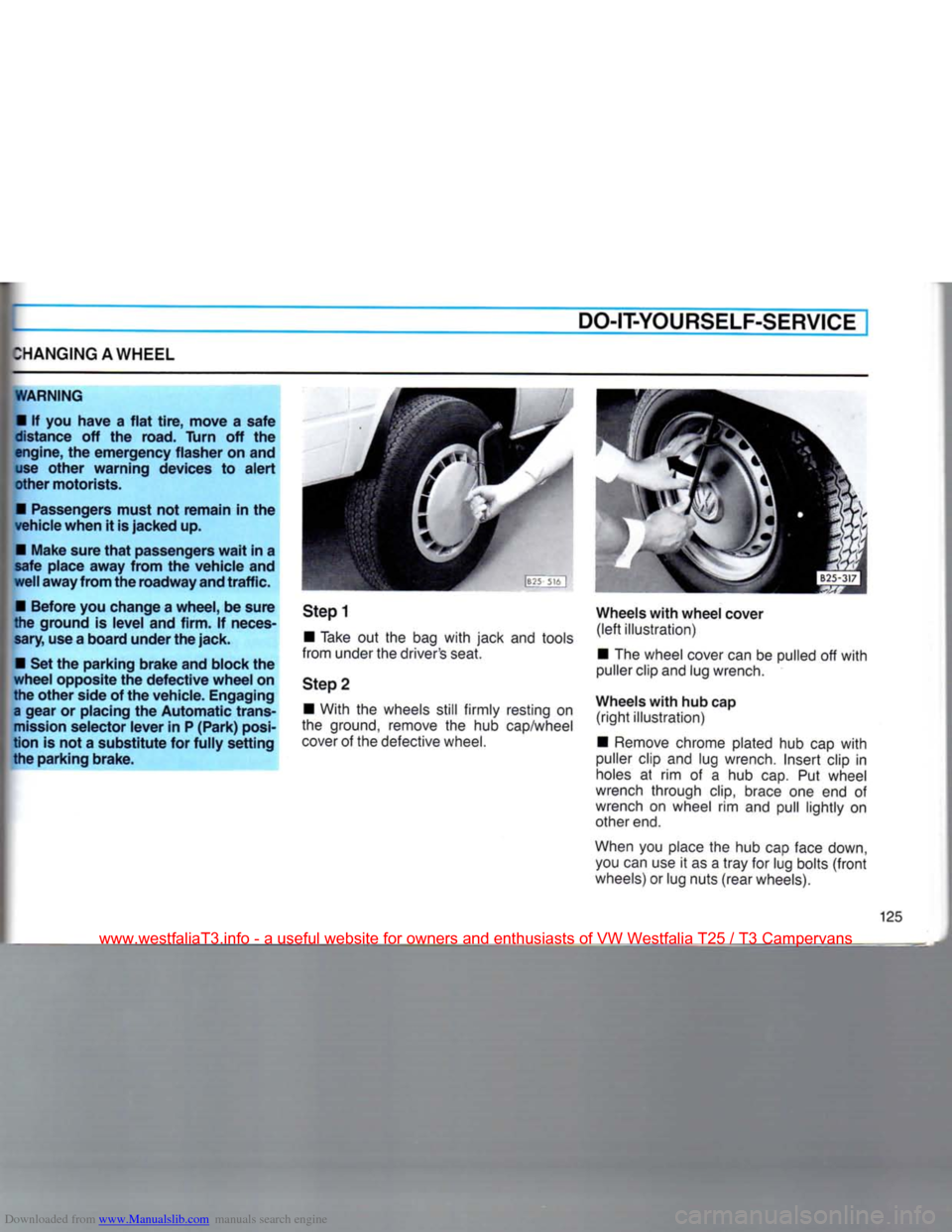
Downloaded from www.Manualslib.com manuals search engine
HANGING
AWHEEL
DO-IT-YOURSELF-SERVICE
WARNING
•
If you have a flat tire, move a safe
distance
off the road.
Turn
off the
engine, the emergency flasher on and use other warning devices to alert
other motorists.
•
Passengers must not remain in the
vehicle when it is
jacked
up.
•
Make
sure that passengers wait in a
safe
place away from the vehicle and
well
away
from
the roadway
and
traffic.
•
Before you change a wheel, be sure
the ground is level and
firm.
If neces
sary, use
a
board under the jack.
•
Set the parking brake and block the
wheel opposite the defective wheel on
the other side of the vehicle. Engaging
a
gear or placing the Automatic trans
mission
selector lever in P (Park)
posi
tion is not a substitute for fully setting
the parking brake.
Stepl
•
Take out the bag with jack and tools
from under the driver's seat.
Step 2
•
With the wheels
still
firmly resting on
the ground, remove the hub cap/wheel
cover of the defective wheel. Wheels with wheel cover
(left
illustration)
•
The wheel cover can be pulled off with
puller clip and lug wrench.
Wheels with hub cap
(right
illustration)
•
Remove chrome plated hub cap with
puller clip and lug wrench.
Insert
clip in
holes at rim of a hub cap. Put wheel
wrench through
clip,
brace one end of
wrench on wheel rim and pull lightly on
other end.
When you place the hub cap face down, you can use it as a
tray
for lug bolts
(front
wheels) or lug nuts
(rear
wheels).
125
www.westfaliaT3.info - a useful website for owners and enthusiasts of VW Westfalia T25 / T3 Campervans